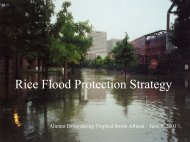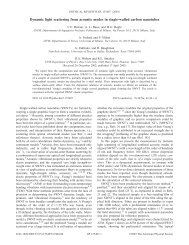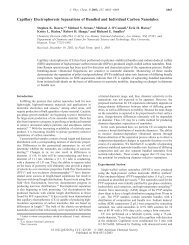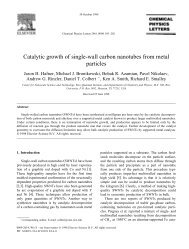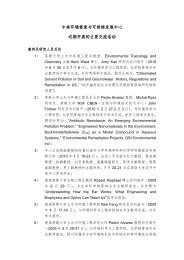Farming vs. Gold Mining in the Nyanga Highlands
Farming vs. Gold Mining in the Nyanga Highlands
Farming vs. Gold Mining in the Nyanga Highlands
Create successful ePaper yourself
Turn your PDF publications into a flip-book with our unique Google optimized e-Paper software.
NYAME AKUMA No. 75 June 2011<br />
and do not negate use of manure. Any protection<br />
of crops from wild animals would<br />
have been <strong>in</strong> organic materials which would<br />
not survive.<br />
Consistent presence of quartz: occurrence<br />
of quartz was not an aspect of my own<br />
research but some comments are <strong>in</strong> order.<br />
Ve<strong>in</strong> quartz and quartz rubble is to be expected<br />
on terraces if occurr<strong>in</strong>g <strong>in</strong> <strong>the</strong> local<br />
geology. If concentrations of “crushed<br />
quartz” were consistently associated with<br />
all pit-structures, I like to th<strong>in</strong>k I would have<br />
noticed it. Her figure 5 seems to show<br />
rounded sand gra<strong>in</strong>s ra<strong>the</strong>r than <strong>the</strong> sharp<br />
angles one might expect from crush<strong>in</strong>g. I<br />
have observed heaps of smallish wea<strong>the</strong>red<br />
fragments of quartz, around a couple of metres<br />
<strong>in</strong> diameter and ten or fifteen centimetres<br />
high, localised on relatively level<br />
unterraced land. I had tentatively <strong>in</strong>terpreted<br />
<strong>the</strong>m as stone clearance dur<strong>in</strong>g cultivation.<br />
Design of pit-structures: <strong>the</strong> “pr<strong>in</strong>ciples<br />
for recovery of a heavy metal by gravity<br />
concentration” are not specified, but can<br />
hardly be exclusive to any o<strong>the</strong>r function.<br />
All <strong>the</strong> regular features of <strong>the</strong>se structures<br />
are equally or more consistent with family<br />
homesteads with livestock; <strong>the</strong>re is no<br />
anomaly here. The term “pit-structure” is not<br />
a misnomer but a simple descriptive label<br />
co<strong>in</strong>ed by Roger Summers (1959), avoid<strong>in</strong>g<br />
any assumption of function. Kritz<strong>in</strong>ger’s<br />
“hydraulic tank systems” leaps to a conclusion<br />
of function which is open to doubt (see<br />
below), symptomatic of <strong>the</strong> whole gold hypo<strong>the</strong>sis.<br />
If <strong>the</strong>se structures she calls “hydraulic tank<br />
systems” (archaeologically known as “pit-structures”<br />
and “pit-enclosures”) were specifically designed and<br />
built for <strong>the</strong> extraction of gold, all <strong>the</strong>ir characteristic<br />
features must be explicable <strong>in</strong> practical terms throughout<br />
<strong>the</strong>ir distribution and <strong>the</strong> distribution must co<strong>in</strong>cide<br />
with workable levels of gold. The latter may be<br />
<strong>the</strong> case but rema<strong>in</strong>s to be demonstrated. It is not<br />
mean<strong>in</strong>gful to select atypical examples to support a<br />
special hypo<strong>the</strong>sis as she has done <strong>in</strong> <strong>the</strong> case of<br />
restricted tunnel entrances.<br />
62<br />
Although she does not cover o<strong>the</strong>r elements<br />
of <strong>the</strong> “tank system” <strong>in</strong> this paper, <strong>the</strong>y merit some<br />
comment. The slots <strong>in</strong> tunnel roofs are hardly<br />
“hopper-like” (though on her figure 3 she labels it<br />
“ventilator”), be<strong>in</strong>g only around 15cm wide and 50cm<br />
long, cut through <strong>the</strong> floor of <strong>the</strong> house above, which<br />
is divided by a low wall, one half be<strong>in</strong>g stone paved<br />
and <strong>the</strong> o<strong>the</strong>r half, at a slightly higher level, hav<strong>in</strong>g a<br />
plastered floor with a hearth. This is reasonably<br />
<strong>in</strong>terpreted as a kitchen/liv<strong>in</strong>g area with accommodation<br />
for small stock such as goats, a traditional<br />
practice <strong>in</strong> this area. The slot is more conv<strong>in</strong>c<strong>in</strong>gly<br />
expla<strong>in</strong>ed as a device through which to drop poles to<br />
block <strong>the</strong> tunnel. Presumably what she calls “work<br />
bays” are what I <strong>in</strong>terpret as house bays, low rough<br />
stone walls surround<strong>in</strong>g clay-walled houses. Her<br />
“oven-type structures” seem to be <strong>the</strong> raised platforms<br />
likely to have supported storage huts; <strong>the</strong> clay<br />
floors of <strong>the</strong>se show no regular evidence of bak<strong>in</strong>g.<br />
The “heavy duty gr<strong>in</strong>d<strong>in</strong>g equipment” consists of<br />
normal gr<strong>in</strong>d<strong>in</strong>g stones for gra<strong>in</strong> and <strong>in</strong> some cases<br />
comparable gr<strong>in</strong>d<strong>in</strong>g hollows <strong>in</strong> adjacent rock surfaces.<br />
To return to <strong>the</strong> focus of <strong>the</strong> present paper: <strong>the</strong><br />
tunnels.<br />
“Restrictive dimensions of uphill entrances”.<br />
This is not a constant feature; <strong>the</strong>re are plenty of full<br />
size entrances and any restrictions are likely to be<br />
due to siltation after abandonment, which appears to<br />
be <strong>the</strong> case <strong>in</strong> her figure 3. S<strong>in</strong>ce many tunnels are<br />
not restricted this cannot be a critical feature, so any<br />
restriction, even if it can be shown to be deliberate,<br />
can only be a modification.<br />
She has not expla<strong>in</strong>ed <strong>the</strong> very standard dimensions<br />
of <strong>the</strong> tunnels, 50cm wide and 1.10m high,<br />
plus or m<strong>in</strong>us about 10cm (observation of <strong>the</strong> dimensions,<br />
not statistically calculated). The width may be<br />
a practical measure, but why <strong>the</strong> height of 1.10m?<br />
Indeed why should <strong>the</strong>y be roofed at all if only for<br />
channell<strong>in</strong>g water flow? Her suggestion that <strong>the</strong> roof<br />
would ensure <strong>the</strong> provision of clean water (2008:26)<br />
is unconv<strong>in</strong>c<strong>in</strong>g; water from artificial furrows would<br />
generally already be clean except after heavy ra<strong>in</strong>fall,<br />
while slope wash from such ra<strong>in</strong>fall would already be<br />
muddy and <strong>the</strong>re is no <strong>in</strong>dication of settl<strong>in</strong>g tanks to<br />
reduce this. The consistent height requires explanation.<br />
This of course also applies to <strong>the</strong> dwarf cattle<br />
<strong>in</strong>terpretation. One explanation could be that <strong>the</strong> tun-





